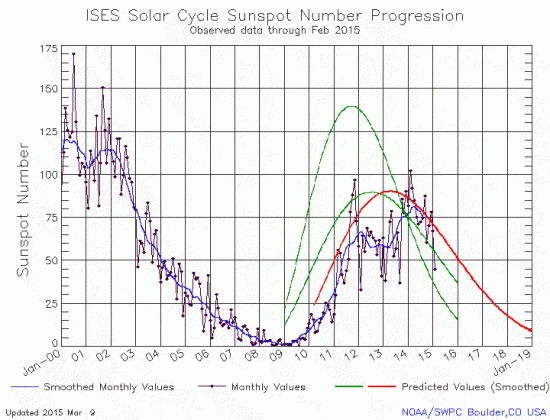Sunspots crash in February
NOAA today posted its monthly update of the solar cycle, showing the sunspot activity for the Sun in February. As I have done monthly for the past five years, I am posting it here below the fold, with annotations to give it context.
In the past two months I have noted how the ramp down from solar maximum has closely tracked the 2009 prediction of the solar scientist community (indicated by the red curve).
In February, however, that close tracking ended, with sunspots plunging far below the prediction. Note also that sunspot activity in March has also been weak.

The graph above has been modified to show the predictions of the solar science community. The green curves show the community’s two original predictions from April 2007, with half the scientists predicting a very strong maximum and half predicting a weak one. The red curve is their revised May 2009 prediction.
Historically the ramp down from solar maximum is slower than the ramp up. You can see this if you look closely at the red and green prediction curves, which are steeper on the upside but more stretched out on the downside. The activity now, however, suggests a faster ramp down than normal, though no one should be surprised if activity increases again and offsets this period of low activity. To find out what will happen we will just have to wait and see. At the moment the solar scientists really don’t understand the reasons why sunspot activity itself has remained so low beginning with the solar minimum in 2009.
I want to add a thank you to the people who run the NOAA website. In upgrading their website for NOAA’s Space Weather Prediction Center, they had initially left out the old links to the press releases for the 2007 and 2009 predictions. I had emailed them about this, and Brent Gordon of their website team responded, making sure that these press releases were once again on line and available to the public.
On Christmas Eve 1968 three Americans became the first humans to visit another world. What they did to celebrate was unexpected and profound, and will be remembered throughout all human history. Genesis: the Story of Apollo 8, Robert Zimmerman's classic history of humanity's first journey to another world, tells that story, and it is now available as both an ebook and an audiobook, both with a foreword by Valerie Anders and a new introduction by Robert Zimmerman.
The print edition can be purchased at Amazon or from any other book seller. If you want an autographed copy the price is $60 for the hardback and $45 for the paperback, plus $8 shipping for each. Go here for purchasing details. The ebook is available everywhere for $5.99 (before discount) at amazon, or direct from my ebook publisher, ebookit. If you buy it from ebookit you don't support the big tech companies and the author gets a bigger cut much sooner.
The audiobook is also available at all these vendors, and is also free with a 30-day trial membership to Audible.
"Not simply about one mission, [Genesis] is also the history of America's quest for the moon... Zimmerman has done a masterful job of tying disparate events together into a solid account of one of America's greatest human triumphs."--San Antonio Express-News


Amazing how this data doesn’t agree with the radio propagation during last weekend’s ARRL DX Amateur Radio Contest. The high bands which depend upon sunspots were quiet and very productive. Stations worldwide were easily workable during expected propagation paths. The 28 MHz band was open for extended periods. These conditions won’t be back for quite a few years if the SS progression continues as plotted.
Thanks for your coverage of this topic.
I should clarify that even though sunspot activity has been weak, sunspots have still been present. It is only weak relative to past solar cycles.